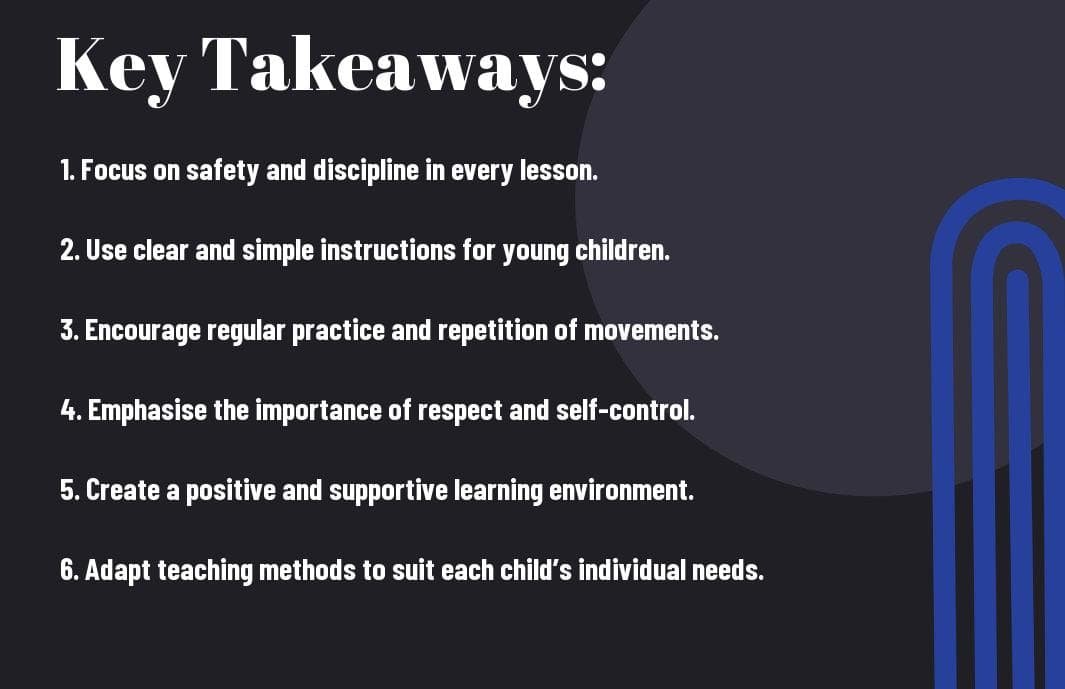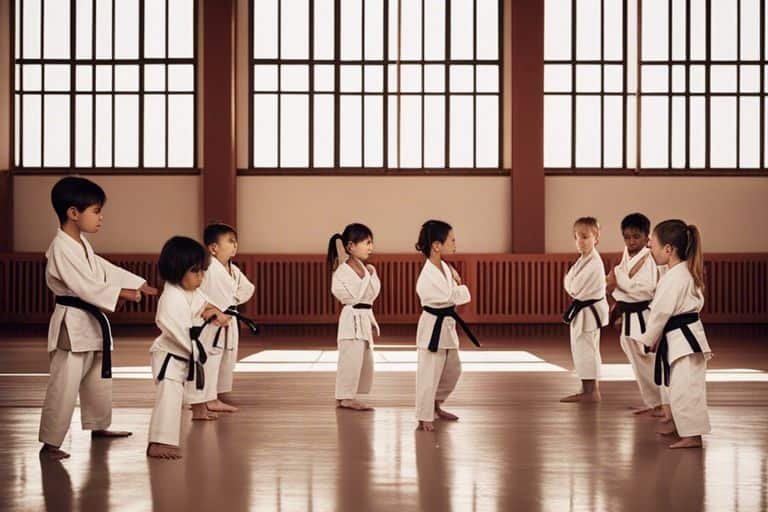Hello there, are you considering introducing your child to the world of Karate? It is important to understand the unique principles of teaching Karate to children in order to ensure their safety and success in learning this discipline. Patience and discipline are crucial when teaching kids Karate, as well as creating a safe and supportive environment for them to learn and grow. In this informative blog post, we will delve into the key principles of teaching Karate to children, helping you to navigate this exciting journey with confidence and expertise.
Key Takeaways:
- Focus on Fundamentals: Teach children the basic stances, blocks, strikes, and kicks in a systematic and structured manner.
- Engage in Fun Activities: Incorporate games and activities to make the learning process enjoyable and promote interest in the discipline.
- Emphasise Discipline: Instil the values of respect, discipline, and self-control within the children to create a positive learning environment.
- Provide Positive Reinforcement: Encourage children through positive feedback and rewards to boost their confidence and motivation.
- Ensure Safety Measures: Prioritize the safety of the children by teaching them to execute techniques carefully and utilizing protective gear during training.

Understanding the Philosophy of Karate
Karate is not just a physical activity, but a way of life. It is a martial art that originated in Okinawa, Japan, and is based on the principles of discipline, respect, and self-improvement. Understanding the philosophy of karate is crucial for effectively teaching it to children. It emphasises the development of character, self-control, and a sense of responsibility, all of which are essential for children’s holistic growth.
The History of Karate and Its Values
The history of karate dates back centuries, and its values are deeply rooted in traditional Japanese culture. The art teaches the importance of respect, humility, and perseverance, which are essential for personal and social development. Karate emphasises the value of hard work, dedication, and self-discipline, which are key principles that are essential for children to learn from a young age.
Building Character Through Karate Principles
Karate is a powerful tool for instilling positive character traits in children. By following the principles of discipline, focus, and resilience, children can develop a strong sense of determination and mental fortitude. These values can help them overcome challenges, set goals, and develop a sense of accomplishment as they progress in their martial arts training.
Developmental Considerations in Karate Training
When teaching karate to children, it is essential to consider their developmental stage and capabilities. This will ensure that the training is not only effective but also safe and enjoyable for the child. For a comprehensive guide on karate for kids, you can also refer to the article Karate for Kids: (The Ultimate Guide). Here are some key developmental considerations to keep in mind when teaching karate to children:
Age-Appropriate Techniques and Drills
It is crucial to tailor the techniques and drills according to the age of the child. Younger children may not have the strength or coordination to perform certain moves, so it is important to start with basic techniques and gradually progress as they develop. This not only prevents injury but also builds a strong foundation for their future training.
Cognitive and Physical Milestones in Learning Karate
Understanding the cognitive and physical milestones at different stages of childhood is important for structuring karate training. For example, a 5-year-old child may have different attention span and motor skills compared to a 10-year-old. By recognising these milestones, you can adapt your teaching methods to maximise the child’s learning potential and overall development.
Teaching Methodologies for Young Karatekas
When teaching karate to children, it is important to use methodologies that are tailored to their unique needs and capabilities. In order to effectively teach young karatekas, it is crucial to implement teaching techniques that create a safe and supportive environment and utilise effective communication and motivation strategies.
Establishing a Safe and Supportive Environment
Creating a safe and supportive environment is paramount when teaching karate to children. This includes ensuring that the training area is free from any hazards, and that all equipment is suitable for their size and ability. It’s also important to establish clear rules and expectations to ensure a disciplined yet nurturing atmosphere. Emphasise the importance of mutual respect and encourage children to support and help each other in their learning journey. By providing a secure and welcoming space, you can ensure that young karatekas feel confident to learn and grow.
Effective Communication and Motivation Strategies
Communication and motivation play a vital role in the teaching of karate to children. It is essential to use clear, simple language and to demonstrate techniques in a way that is easy for young learners to understand. Encouraging and praising efforts and achievements is a powerful tool for motivating children to improve. By recognising their progress and providing constructive feedback, you can help young karatekas stay engaged and enthusiastic about their training.
Structuring a Child-Friendly Karate Curriculum
When teaching karate to children, it’s crucial to have a curriculum that is tailored to their needs and abilities. A child-friendly karate curriculum should focus on building their confidence, discipline, and physical fitness while also making the learning experience enjoyable and engaging. To get some tips on how to structure your karate curriculum, you can check out this Quora post related to ‘What are some tips for Teaching a Kid’s martial arts Program’.
Breakdown of Essential Karate Techniques for Children
When teaching karate to children, it’s important to focus on the fundamental techniques that form the basis of the martial art. You should prioritise teaching basic stances, punches, kicks, and blocks. Emphasise the importance of proper form and technique, as this will set a strong foundation for their karate skills. It’s critical to pay special attention to safety and injury prevention, ensuring that children understand the potential dangers of incorrect movements and the importance of respecting their own and others’ physical boundaries.
Incorporating Games and Play into Karate Sessions
Integrating games and play into karate sessions can make the learning process more enjoyable and effective for children. Incorporating activities such as relay races, obstacle courses, and team-based games can help improve their agility, coordination, and speed while keeping them engaged and motivated. Additionally, using games to teach important karate principles and techniques can help children retain the information more effectively. It’s important to strike a balance between playfulness and discipline, ensuring that the games serve as a complementary element to the overall learning experience.
Assessing Progress and Providing Feedback
When teaching karate to children, it is essential to assess their progress regularly and provide constructive feedback. You should create a system for tracking their development in skills, discipline, and mindset. This will help you understand each child’s strengths and areas for improvement, allowing you to tailor your teaching to their individual needs. Furthermore, providing feedback on their performance will help them understand how they are progressing and what they need to work on.
Goal Setting and Reward Systems
Setting goals for your students is a great way to motivate them and provide a clear direction for their development. By involving them in the goal-setting process, you can ensure that they are invested in their own progress. Additionally, implementing a reward system for when they achieve these goals can be highly effective. Whether it’s a simple sticker chart or a more elaborate system, rewards can reinforce positive behaviours and incentivise children to work towards their objectives.
Recognizing and Celebrating Achievements
It is crucial to recognise and celebrate the achievements of your students, no matter how small. This can be done through verbal praise, certificates of achievement, or even small ceremonies at the dojo. Celebrating their progress will boost their confidence and self-esteem, and motivate them to continue improving. It is also important to be mindful of not only celebrating physical achievements but also positive attitudes, effort, and perseverance.
Challenges and Solutions in Kids’ Karate Training
When teaching karate to children, you will inevitably encounter a range of challenges that come with the territory. It’s important to be prepared and have strategies in place to address these challenges effectively, ensuring that the learning process is smooth and enjoyable for your young students.
Managing Different Skill Levels and Personalities
One of the key challenges you may face in teaching karate to children is managing different skill levels and personalities within the same class. Some children may pick up techniques quickly, while others may struggle to keep up. Similarly, you may encounter students with varying levels of confidence and discipline. It’s important to acknowledge and respect these differences and tailor your teaching approach to accommodate each child’s unique needs. By offering individual attention and guidance, you can ensure that every child feels supported and motivated to make progress.
Overcoming Common Hurdles in Children’s Learning Process
Children’s karate training can often be hindered by common hurdles such as lack of focus, impatience, or being easily discouraged. As a karate instructor, you have to remain patient and understanding, providing clear and consistent guidance. Implementing engaging and interactive training methods can help to keep children focused and motivated, while also addressing any issues with impatience or discouragement. By creating a positive and nurturing learning environment, you can help your students overcome these hurdles and thrive in their karate practice.
Conclusion: Principles of Teaching Karate to Children
On the whole, it is important to remember that teaching karate to children requires a different approach than teaching adults. You need to create a safe and inclusive environment, focus on fun and engagement, and be patient and supportive of each child’s individual progress. By adhering to these principles, you can effectively teach karate to children and help them develop discipline, confidence, and physical fitness.
FAQ
Q: What are the principles of teaching karate to children?
A: The principles of teaching karate to children include patience, positive reinforcement, safety, proper technique, consistency, and age-appropriate instruction.
Q: Why is patience important when teaching karate to children?
A: Patience is important when teaching karate to children because they may learn at different paces and require repetition and encouragement to grasp the techniques.
Q: How can positive reinforcement be used in teaching karate to children?
A: Positive reinforcement, such as praise and rewards, can be used to motivate children and boost their confidence when learning karate.
Q: What measures should be taken to ensure the safety of children learning karate?
A: Safety measures should include proper supervision, use of protective gear, and teaching children the importance of self-control and respect for others during training.
Q: Why is it important to focus on proper technique when teaching karate to children?
A: Focusing on proper technique from the beginning ensures that children develop good habits and reduces the risk of injury as they progress in their training.
Q: How can consistency benefit the teaching of karate to children?
A: Consistency in training and instruction helps children build a strong foundation and creates a sense of discipline and commitment in their practice of karate.
Q: What is the significance of providing age-appropriate instruction in karate for children?
A: Providing age-appropriate instruction ensures that children are learning in a way that is suitable for their physical and cognitive development, leading to better understanding and engagement in their karate training.



